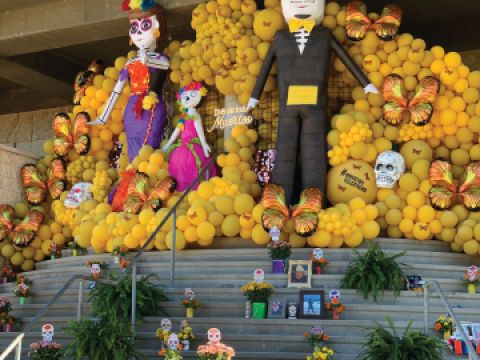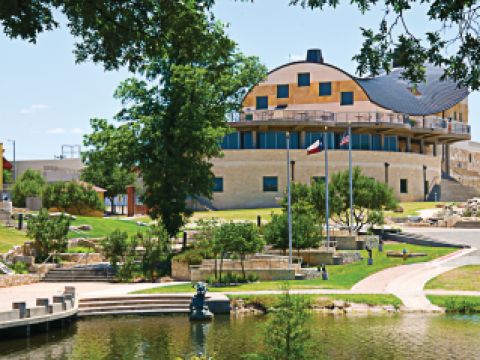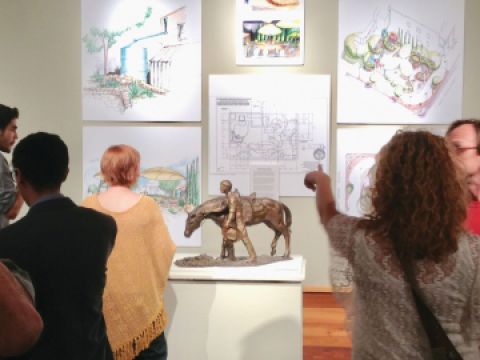
The community is always the focus of San Angelo Museum of Fine Arts.
This article originally appeared in the March/April 2022 issue of Museum magazine, a benefit of AAM membership.

At a recent exhibition opening at my institution, San Angelo Museum of Fine Arts, I was talking with a founder of our museum and a colleague from a major museum. My museum friend commented on the turnout—nearly 600 people—and the diversity of the audience in terms of age, culture, race, and the presence of students and military people. He also observed that, despite the festive and noisy atmosphere, people were “actually looking at the art!”
Our founder replied, “Yes, when we were planning this museum, we never thought it would be like this … and it’s wonderful!” This was one of those magic moments when the efforts of many years were apparent to both a distinguished outsider and a key individual within our community.
We have endeavored to create a welcoming environment, marketing our programs, including exhibition openings, to all segments of the community. Openness pervades everything at the museum, from publicly accessible offices and work areas to visible and open collections storage. There are no “staff only” signs posted, and yet we maintain the highest levels of protection for our people, collections, and exhibitions. As an accredited museum, we carefully follow the AAM standards for our field. In our quest to be a transformative organization, however, many of our activities depart from the usual museum practices.
Mike Murawski perfectly summed up the intentions behind our efforts in his article in the November/December 2021 issue of Museum: “At its foundation, being a more human-centered museum involves shaping and productively debating a set of core values that reflect a commitment to equity, justice, and human rights. When we put people first—above collections, above endowments, above budget spreadsheets—we are making a commitment to advance compassion, care, human potential, and collective well-being as integral elements to our institution’s values and culture.”
Building True Community
When I was interviewed by the founding board before our museum opened, I said that if we define the museum by the size of the four walls, we will never be larger. But if we define it as the size of our community, we will be one of the largest museums in the country. As institutions devoted to engaging the people in our communities, museums cannot turn a blind eye to either their organizational built and social environments or those that exist beyond our doorsteps.

Brooke Mulkey
From that day forward, we have used a phrase that perfectly expresses our vision: “We are not just about art on the walls but art in our lives, and the community is the greatest work of art.”
The board’s enthusiastic response to the ideas I discussed in that interview prompted my move to this small (population 100,000) city in West Texas. I intended it to be an experiment that would last two years. It has turned into a 37-year detour! Today, the museum has a $2 million budget, 14 full-time and 40 part-time employees, and average annual attendance of 65,000.
Over the years, our initiatives have focused on engaging with both the social and built environment. For the social environment, we have always tried to bring together people of different backgrounds. On our board, for example, we have a broader mix than most museums, which includes individuals who are stay-at-home moms and teachers, in addition to people with significant financial resources. There is an atmosphere of respect for the different perspectives that emerge at our board and committee meetings.
For the built environment, the challenge is to create spaces and places, with genuine input from the various populations of the community, where people can converge, share, and get to know each other. One of the first things we did as a museum was a series of exhibitions called “Visions and Choices” in which community members submitted ideas for creating a better place.
No two of these exhibitions—held every five or so years over a 25-year period—looked alike. We had drawing boards with markers and materials for people to write down or illustrate ideas, and we would then post them on the walls. There were also more formal presentations, such as one by an architectural firm that featured a large kiosk with beautiful renderings of a variety of concepts. The museum built a detailed model of the historic city center that we used to stimulate ideas about how to revive that area, which today is vibrant and utterly transformed. The exhibits were colorful and messy and continuously changing throughout their duration.
We spent a lot of time soliciting the input of people from different racial, ethnic, and occupational backgrounds to get the level of participation we sought in “Visions and Choices,” and we worked hard to consolidate the ideas and advocate for their implementation. For example, many participants were advocating for historic preservation projects. At that time there was no active preservation group here, so the museum helped create such a group. It has gone on to save and restore numerous structures and reinvest in important historical assets, including a park that had long been a community meeting place in a traditionally African-American neighborhood. Our youth participants advocated for many projects as well, including a skateboard park. In a panel review of a grant application to the Texas Commission on the Arts for this project, a panelist remarked, “This is not art!” Happily, the other panelists disagreed.
Another significant outcome of “Visions and Choices” was a project through the American Institute of Architects (AIA) and its Regional/Urban Design Assistance Team (R/UDAT) that brought to fruition many of the ideas from the exhibitions. AIA sent a group of eight volunteer architects, planners, and landscape designers and nine architectural students from Texas Tech University to meet over three intensive days with our local community team. The R/UDAT team and our local committee set up dozens of interviews with community leaders and citizens; looked at the range of ideas presented through our “Visions and Choices” exhibitions; and developed a plan for project implementation, which was published in our local newspaper.

Courtesy of San Angelo Museum of Fine Arts
We used the momentum behind this work to bring our city council and city manager’s team to the table, and after an initial lack of interest by city government, we were able to get significant buy-in and enthusiasm. This led to $70 million in funding for a wide range of projects, with resources coming from a city bond issue, multiple private fundraising initiatives, individual entrepreneurs spurred by the R/UDAT project, and individual and foundation funding.
A notable R/UDAT project was the creation of a 30-acre public event space that includes a farmers market, restoration of a historic railroad depot and warehouse for use as a transportation center and museum, a senior citizens center, pavilion structures for public events, and ultimately the construction of the new San Angelo Museum of Fine Arts.
Our museum also acquired a block of historic buildings that were in a state of collapse, and we restored and adapted them for a range of community activities. The buildings now house two galleries that we have dedicated for community use, including by high school students and church and other community groups.
Currently, in our 18-county educational service region (which is the size of West Virginia), we are working on several projects that will connect, celebrate, and engage the people in this vast and sparsely populated area. For example, we are working with a leading folklorist to seek out artisans, folk artists, and other creative people in the area. The results of this undertaking include two exhibitions featuring the individuals identified in this study and related publications and programs. With this initiative, we hope to develop a combination of amenities for visitors and marketing plans for what would be the first “Artisan’s Trail” in Texas.
And, in a daily example of our community focus, we provide free access to our 300-person meeting room for up to 100 groups a year. For many museums that might represent an unacceptable loss of potential income, but by doing this we have become a place where groups can converge on common ground that has become difficult to find today.
Despite our intensive commitment to the community and helping others, traditional museum functions have not suffered. In fact, we have built significant collections, created widely recognized exhibitions, and won numerous national awards for our exhibitions and programs.
Representing Our Community
Cultural diversity is central to our agenda. Approximately a third of our education programs, exhibitions, and collecting efforts are about and for the people of our community. And our board of trustees, staff, volunteers, and sponsors parallel the demographics of our community, which in San Angelo is about 45 percent Hispanic, 3 percent African American, about 3 percent Asian American and other, and approximately 48 percent white.
The museum has purchased display cases to be used in several libraries 90-plus miles away and has sent our educators and director to hold programs in these communities—even though the audiences are generally very small. We have online programming, but we believe it is also important to have one-on-one and face-to-face engagement.
Like most museums, we must continuously seek the funding and resources we need to carry out our programs. Nevertheless, we have worked with other organizations on their own development efforts. For example, we helped our public library raise funds for the construction of an award-winning facility, and we are currently helping a local group that is working to establish a Hispanic Heritage Museum and Cultural Center. Through a collaborative fundraiser, we were able to provide substantial funding for their efforts.
Several years ago, I was the last speaker on a museum panel about diversity. As the panelists who preceded me talked about their studies and outcomes, I began to shrink in my seat. The other panelists were from major institutions operating at a level of sophistication that my museum could not match.
However, as I listened to their outcomes, I could also see that our museum had significantly exceeded their results. One speaker noted that on their 50-person board of trustees, they had added three people from underrepresented backgrounds. On our board of 20 people, about one-third were non-white, and we had a similar pattern with our staff, closely paralleling our regional demographics. We have always prioritized being as representative of the community as possible.
When it was my turn, I offered this advice: even without consultants and studies, you can engage your community by getting to know it personally and overcoming your inherent biases. At San Angelo Museum of Fine Arts, we are far from achieving perfection in our attempts to be as inclusive and transformative as we wish to be, but we will persist in our vision.
How to Be a Better Community Resource
Know your community. Every grant asks for a description of your demographics, which you can find in your census study. In addition to data gathering, engage with your community to assess how you can better serve it.
Never forget that you are a human being leading a human institution. Don’t just work on networks and relationships; form real personal friendships within your underrepresented communities.
Recognize that we all possess inherent biases. Dig deep and engage with others to help you see the bigger picture of the various communities and people that comprise them.
Engage your board members in AAM Museums Advocacy Day and other advocacy efforts. Museum trustees are leaders in their community and are often politically active and sometimes significant donors to politicians. In our lobbying efforts, their voices stand out. Conversely, it is helpful for our trustees to be aware of the issues we face as a field. Our immediate past and current board chairs have participated in AAM Museums Advocacy Day in Washington, DC.
Buy ads in local media. Our museum newsletter, which is on newsprint and has articles in Spanish and English, is inserted into our regional English-language and Spanish-language newspapers. Rather than going to members only, it reaches over 50,000 people.
Just do it! Learning what your community needs doesn’t need to be expensive or complicated, but it does require sustained outreach and listening.








Comments